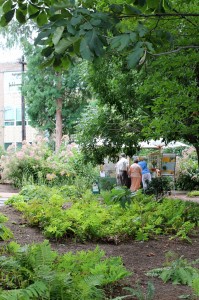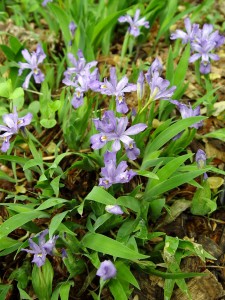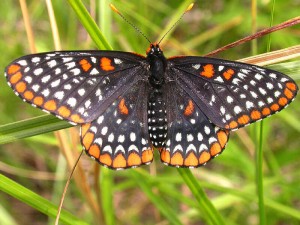Gardening Guesswork
August 14th, 2012
Gardening is not easy, if you haven’t figured that out yet.
It’s especially frustrating when you plant something that’s supposed to work in what you think is a good spot, only to see it struggle. Or croak.
The more you know about plants and their little intricacies, the better your odds of sidestepping those trying surprises.
But even for experienced plant geeks, it’s still a guessing game. You never really know how a plant is going to perform in a given spot until you plant it and see.
That’s what I’ve always found, so it was kind of comforting and reassuring to talk to Dennis Rydberg over at the Governor’s Residence on Sunday.
Dennis is a horticulturist who spent most of his career working for the state, including the Governor’s Residence at Front and MacClay streets since the 1990s. He’s now semi-retired.
What I found interesting is the difficulty the staff there has had getting the decade-old Penn’s Woods shade garden to thrive.
The idea of this garden – about the size of two tennis courts side by side – is to show off plants native to Pennsylvania. You’d think that would be easier than, say, growing masses of annuals or a garden full of supposedly finickier imported species.
But despite using “easy-to-grow” natives, this garden still has a lot of bare space.
Some plants have done well, but Rydberg says many others have “just sat there” or fizzled altogether.
Only one mountain laurel – the official Pennsylvania state flower – is left, and it’s showing some dead tips.
Some ferns didn’t like it there, and although the planting of Pennsylvania sedge grass is alive, it hasn’t really taken off.
The one that really surprised me was crested iris. I would’ve predicted that shorty native would’ve colonized nicely in the woodland shade, but Rydberg says it’s stayed about the same-size patch for years.
Part of the lesson is that native or not, every plant has specific places where it’s going to be happy and specific places where it’s not. Some things are pickier about that than others.
Rydberg has come to the conclusion that the best plan is to figure out the exact conditions you’ve got and then go with plants that are native to those conditions.
That’s a lot easier than trying to change your conditions to match the conditions of the plant you’d like to grow.
Even so, it’s nearly impossible to ferret out every last factor that could affect the success of a plant.
Not everything is obvious – especially which animals might show up and eat even the species on the “don’t-like” list. (Note: Animals don’t read those lists.)
In the case of Penn’s Woods, Rydberg says the staff knew they were dealing with clay soil and would also have to cope with competition from the tree roots.
“This land was once a swamp,” he says. “The top 5 feet is clay. My biggest searches online are for ‘wet clay.’”
But what no one knew until a nearby planting of inkberry holly and liriope went in was that a spring runs very close to the surface just under the ground in that area.
That means in times like last fall – when the river flooded that section of the Governor’s Residence – it can take forever for the root-rotting soil to drain. But in drought years, the same area could end up in dry shade with clay soil and root competition.
It’s a tall order for any plant – no matter where it comes from.
Rydberg says the staff’s strategy has been to “buy small quantities and test them. If they don’t work, we move them somewhere else.”
Sometimes moving a plant just a little, say to a slightly sunnier spot or a few more feet away from the wettest spot – is enough to make the difference.
This makes great sense for home gardens, too. Before buying 35 coneflowers, try a few and see how they do over the course of a year or two. If they work out, add more. If not, assess why they didn’t do well and get something else that doesn’t have that weakness.
Also don’t be afraid to move plants. I’ve found that plant geeks usually have moved every plant in their garden a minimum of three times until everyone is happy.
In Penn’s Woods, Rydberg says some of best native performers in wet clay have been Heuchera villosa (the native coralbell), turtlehead, foamflowers, Jack-in-the-pulpit and Christmas and ostrich ferns.
A patch of wood asters also was looking pretty good.
One other interesting little sidelight from this garden… the holes in the turtlehead leaves.
Rydberg says they’re the work of the Baltimore checkerspot butterfly caterpillar, which somehow found this little patch in the middle of an urban asphalt island.
“Chelone (turtlehead) is only herbaceous plant that butterfly eats,” says Rydberg. “It’s neat to see how we can have a native butterfly here on a native plant. Twenty-five years ago we’d have been spraying everything, and there wouldn’t be anything alive.”










